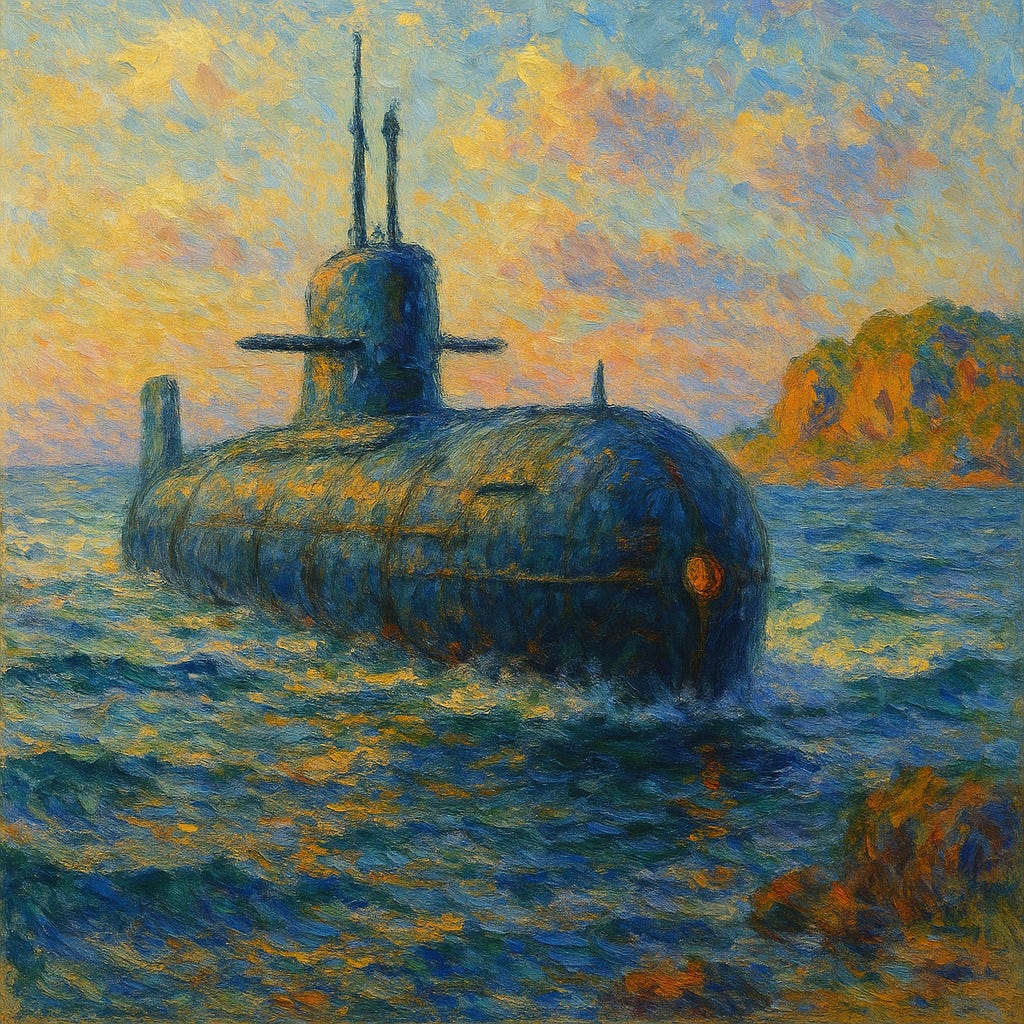Australia is set to get its first conventionally armed, nuclear-powered submarines in the early 2030s. This is under a partnership with the UK and the USA, signed in November 2024. It seemed curious to me that Australia already does not already have these, so I decided to look into which countries have them, who first developed them, and why they’re still so rare.
Six Countries
The first nuclear submarine, the USS Nautilus, was launched in 1954 by the US. Not surprising since this is where the first nuclear reactors were also built1. Westinghouse provided the reactor, which allowed the submarine to stay underwater for weeks. Before this, diesel submarines had to resurface every 48 hours to refuel. The Soviets launched their first nuclear submarine, the K-3 Leninsky Komsomol, in 1958.
Seventy one years after the first nuclear submarine was launched, only 6 countries, across the entire globe, have them
USA
the UK
Russia
China
India
France
Australia will be the 7th country to get one, followed by Brazil.
Australia’s case is unique in that it has no nuclear capabilities otherwise - in defense, or for civilian applications. The UK and US will be sharing nuclear submarine technology with it, under special approval from the IAEA, and with Australia having signed a non-proliferation agreement.
Ballistic and attack submarines
Nuclear submarines are designed for 2 primary capabilities
ballistic - wait and disappear at sea for months; they carry long-range (8000km+) missiles; and primarily serve as deterrents
attack - seek out targets such as other submarines, vessels, or land targets
All 6 countries have both kinds.
Why so rare?
Naval reactors have specific needs:
must be compact
high endurance - able to handle shocks, vibrations, collisions, high pressure, flooding of reactor compartment, saltwater corrosion
allow for frequent change in power output - land-based reactors are typically run at a constant power output for long periods2
be quiet - noisy reactors can be detected by enemy fleets
operate without refueling3 and without waste removal for long periods (10-30+ years)
The price tag is also a factor. The US has 40 Virginia class subs, acquired at about $4.5 billion each.
The Navy has been procuring Virginia (SSN-774) class nuclear-powered attack submarines (SSNs) since FY1998, and a total of 40 have been procured through FY2024. From FY2011 through FY2024, they have been procured at a rate of two per year. When procured at that rate, they have an estimated procurement cost of about $4.5 billion each. Congress.gov
The estimated cost for the Columbia class, in 2025 is $15.2 billion and $9.3 billion.
The UK, in the 1980s, acquired the Trident class of submarines at an expense of GBP12.52 billion for 4 boats (GBP23 billion in 2024/25 prices). These are pricey to maintain too:
Annual in-service costs had been estimated at around 6% of the defence budget (amounting to around £3 billion per year in real terms up to 2022/23). parliament.uk
The French acquisition of these cost about €10.4 Billion in 2014 for six. Australia is expected to spend A$268–368B over 30 years for the new capabilities.
The host country also needs specialised infra for nuclear submarines- shipyards, industrial infra, specialised personnel.
All currently operational nuclear submarines use Pressurised water reactors (PWRs). I’m curious to see if the advent of SMRs allows more countries to acquire these machines, while also making them cheaper to acquire.
Annex: Russia’s naval nuclear lead
The nuclear submarine programme in the Soviet Union was lead by Anatoly Alexandrov. A nuclear physicist by training, Alexandrov
built a system of degaussing - de-magnetising ships to protect them from magnetic mines4
lead development of the first and subsequent generations of nuclear submarines
introduced civilian nuclear power - for electricity and for icebreakers
Chicago-Pile 1 was the first reactor, built by scientists at the University of Chicago in 1942 (see Richard Rhodes’ The Making of the Atomic Bomb). In the early 1960s, General Atomics built some of the first commercial reactors for civilian use, like the TRIGA - interesting story about this in Freeman Dyson’s Maker of Patterns.
their inability for rapidly changing output makes them unsuitable for grid regulation
More on fuel choices from ChatGPT
Fuel choices: HEU vs LEU (and the tradeoffs)
U.S./U.K. typically use weapons-grade HEU (~93% U-235) to enable lifetime cores without refueling.
Russia/India generally use mid-range HEU (~20–50%); China/France use LEU (<20%) and refuel periodically (France’s newer naval fuel is ~7.5% “Caramel”; Barracuda/Suffren program moved to civil-grade ~5%). Each choice shifts the balance among core size, refueling interval, and proliferation risk.
Another one of those incredulous inventions and counter-defenses that happened during World War II. The Germans developed magnetic mines - underwater mines that would explode not on contact, but on detecting a ship’s magnetic field. Ships, made of steel, act like large magnets, and the mines were able to detect this magnetic field. The Germans placed these along key shipping routes, causing major loses to their opponents in the war. The Allies responded by developing a) magnetic minesweeping systems, b) degaussing systems. A degaussing system involves setting up electric cables around the ships’s hull. When current is passed through the cables, the resulting magnetic field cancels out that of the ship’s body, and the ship no longer triggers the mines magnetic field detection system.


